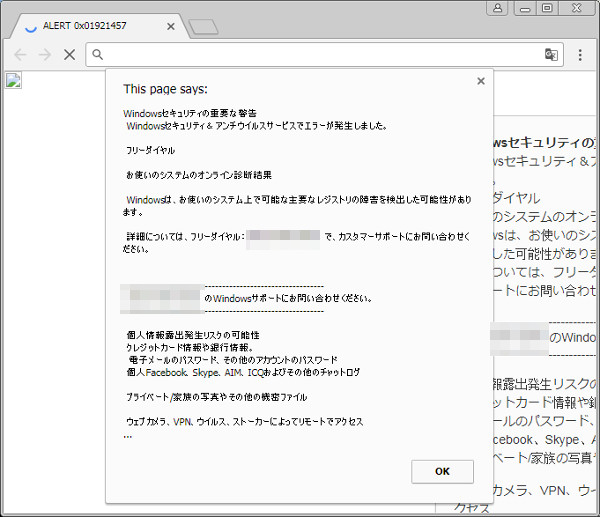HTML_FAKEALERT.AED
Trojan.HTML.Fraud.mt (Kaspersky); SupportScam:JS/TechBrolo.L (Microsoft); JS/FakeSecurityAlert (NAI)
Windows


Threat Type: Trojan
Destructiveness: No
Encrypted: No
In the wild: Yes
OVERVIEW
Dropped by other malware, Downloaded from the Internet
This Trojan arrives on a system as a file dropped by other malware or as a file downloaded unknowingly by users when visiting malicious sites.
It does not have any propagation routine.
It does not have any backdoor routine.
TECHNICAL DETAILS
7,371 bytes
HTML, HTM
No
21 Aug 2017
Displays graphics/image
Arrival Details
This Trojan arrives on a system as a file dropped by other malware or as a file downloaded unknowingly by users when visiting malicious sites.
Propagation
This Trojan does not have any propagation routine.
Backdoor Routine
This Trojan does not have any backdoor routine.
Other Details
This Trojan requires the following additional components to properly run:
- {malware path}\welcome.mp3
- {malware path}\alert1.html
- {malware path}\alert.html
NOTES:
It displays the following fake alert message telling the users to contact the fake Customer Support number:

Closing the message will display a Print dialog, asking the user to print the fake alert message.
SOLUTION
9.850
13.584.02
09 Aug 2017
13.585.00
10 Aug 2017
Step 1
Before doing any scans, Windows XP, Windows Vista, and Windows 7 users must disable System Restore to allow full scanning of their computers.
Step 2
Close all opened browser windows
Step 3
Scan your computer with your Trend Micro product to delete files detected as HTML_FAKEALERT.AED. If the detected files have already been cleaned, deleted, or quarantined by your Trend Micro product, no further step is required. You may opt to simply delete the quarantined files. Please check this Knowledge Base page for more information.
Did this description help? Tell us how we did.
